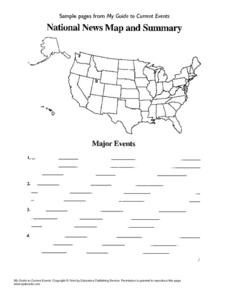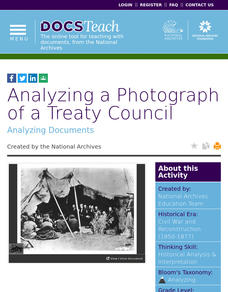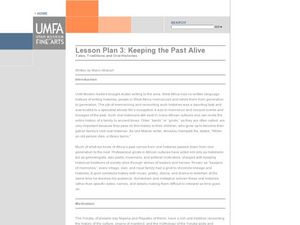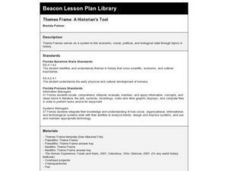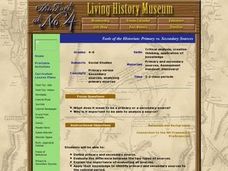Museum of the American Revolution
Historical Analysis: Objects Tell Stories
Dig this! Young archeologists discover what objects teach us about the past. The activity uses an image of a Revolutionary War artifact to help historians practice analyzing the past. Scholars study the object and complete a worksheet to...
Facing History and Ourselves
After Charlottesville: Public Memory and the Contested Meaning of Monuments
Are Civil War monuments a kind remembrance or a reminder of a dark past? The instructional activity focuses on the public's memory of the Civil War and the monuments that represent it. Young academics explore past efforts to change...
Briscoe Center for American History
Identifying Primary Source Documents
Who is Mary Maverick and why is she important? the focus of this, the second in a series of five lessons that are designed to introduce middle schoolers to how historians use primary source documents to understand the past, is on how to...
Denver Art Museum
Lesson: High Prestige and Status
Prestige and status have been symbolized in many different ways throughout human history. Young art historians analyze an ancient Panamanian medallion for symbols of prestige and status, and then generate a list of other symbols of...
Curated OER
Daily Life in Spanish St. Augustine 1565-1763
How do we know so much about the past? A student-crafted presentation provides viewers with images of artifacts from St. Augustine, Florida that give historians and archaeologists clues into lives already lived.
Alabama Department of Archives and History
Changes in Transportation over Time
Planes, trains, and automobiles. How many ways to travel are there? Scholars learn about modes of transportation in the past and how they have changed over time. Budding historians view a timeline, participate in group discussion, and...
Educators Publishing Service
My Guide to Current Events
Keep your youngsters abreast of current events with these activity worksheets! Or, consider what historical events throughout early American history would have looked like on a national newspaper? Your young historians will become...
The Alamo
The Alamo - Remembering Through Education
Help young historians truly remember the Alamo with a comprehensive set of informational text about the Texas Revolution. Complete with important vocabulary, biographies of prominent historical figures, thorough timelines of events, and...
DocsTeach
Analyzing a Photograph of a Treaty Council
A photo catches a moment in time that provides a glimpse into the past. An interesting resource focuses on historical analysis using an image from a treaty council with Native Americans. Budding historians complete an online worksheet...
DocsTeach
Exploring America's Diversity: Motel Garber (Beginner)
Young detectives delve into the past in an exciting series exploring immigration. The activity uses primary sources to teach elementary scholars historical analysis. Academics read records to understand the life of Motel Garber, from...
DocsTeach
Ports of Immigration: Angel Island and Ellis Island
Young historians travel back to the past to explore immigration in the United States. Scholars match images of immigrants to Angel and Ellis Island. The activity also includes a worksheet and a short group discussion to understand...
DocsTeach
Martin Luther King, Jr. and the Fight for Civil Rights
Find clues to the past with photos! Young historians use a photo from one of Martin Luther King Jr.'s peaceful protests to practice photo analysis. Academics look at the image to gain clues about what is happening and why. To finish,...
University of California
Migration of Early Humans: Evidence and Interpretations
While much of prehistory is cloaked in mystery, ancient ancestors left evidence in DNA, languages, and materials from their time. Using photographs of items such as cave paintings and ancient tools, as well as maps of linguistic patterns...
Curated OER
1920s Consumer Culture
Students are immersed in the following goals of learning: The importance of consumerism in the 1920's. Also have learners recognize the connections between commodities and culture in the American past and present. Finally the ability for...
Polk Bros Foundation
Assess with Charts: Compare and Contrast
If you're short on time and need a quick graphic organizer to help your learners connect history to the present, check out this resource. This worksheet can be useful for a visit to a museum or in conjunction with a reading assignment,...
Curated OER
Abraham Lincoln and the Arts
Students engage in a study of history and how the figure of Abraham Lincoln has evolved into a national cultural icon. They discuss the importance of his life and how he influenced the political landscape of America in the past and present.
Curated OER
Keeping the Past Alive
Young scholars read about the oral histories of West Africa and complete related activities. For this oral histories lesson, students read about the importance of oral customs in African cultures. Young scholars interview a family member...
Curated OER
Themes Frame: A Historian's Tool
Learners research the scientific, economic, and cultural themes that connect Paleolithic and Neolithic inhabitants. They complete Paleolithic and Neolithic Theme Frames, comparing/contrasting the two cultures in an essay or Venn diagram.
Curated OER
Tools of the Historian: Primary vs. Secondary Sources
Students identify the difference between primary and secondary sources. They discuss the importance of evaluating all sources they might use. They read primary and secondary sources that relate to the colonial period.
Curated OER
Detectives of the Past: Dr. Archaeology Travels Back in Time
Students watch a video and complete a webquest to gain a better understanding of the historical significance of the first known civilization, Mesopotamia.
Curated OER
Eyes From the Past
Learners view examples of classical Victorian artwork. Using a painting, they discuss their own opinions about what they believe the artwork is trying to tell them. In groups, they compare and contrast the artwork of Robert Harris and...
Curated OER
Civil Rights and Casualties of Wartime
Do your historians fully grasp the consequences of being at war? Help them connect past with present through this group research activity, which has students analysing repercussions suffered by citizens of countries in conflict. Students...
Curated OER
Turn-of-the-Century Child
Learners are put in the role of historians and develop strategies for applying methods in historical inquiry:
Curated OER
Face to Face with the Great Depression
Young scholars develop an analytical perspective of how historians record, preserve, and interpret data. In this US history lesson students read and interpret personal accounts of the Great Depression. They discuss how interpretation...








